Kayıtlar
Mart, 2023 tarihine ait yayınlar gösteriliyor
Reported Selective Differentiation for Globe Seismic Activity
- Bağlantıyı al
- E-posta
- Diğer Uygulamalar
Documented Geomagnetic Storm Conditions
- Bağlantıyı al
- E-posta
- Diğer Uygulamalar
Experimental evaluations about Chile Seismic Event based on Gravimetry&Geomagnetic Storm Data
- Bağlantıyı al
- E-posta
- Diğer Uygulamalar
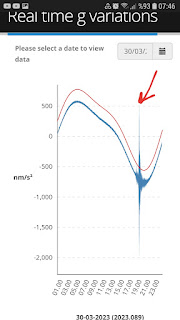
UTC time transform considering GMT time says a condition as 17:00 ~...So,understanding perfect correlation 17:33:06(UTC) information of M6.0 env Chile event👍 If NOAA dataset discusses by GMT time,position of event after Geomagnetic Storm Conditions Ekrem Erkuş Geophysics Engineer UPDATE APRIL 1: By the way,I thought necessity of sharing some informations about 'roles of Gravimetry' considering needs of some geoenvironments... Gravimetry is the study of the measurement of gravity ("g") and its variations in time and space. g depends on : Latitude; Mass repartition in the Earth; The Earth’s rotation (speed and position of the rotation axis); The seasons (groundwater mass variations); The relative position of the Moon and the Sun, which generate tidal forces. Crustal Deformations: Until recently, measuring vertical land movement could only be achieved using repeated levelling measurements. This was done using theodolites since the end of the XIXth century. However,
Santiaguito Developments
- Bağlantıyı al
- E-posta
- Diğer Uygulamalar
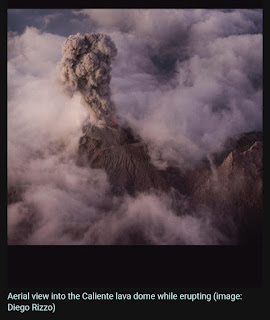
The extrusive-explosive eruption of the volcano continues at high levels. A visible night-time glow and near-constant emissions of gas and water vapor (so-called degassing) indicate the continuing rise of fresh viscous magma accumulating into the Caliente lava dome. Pilling lava material makes the dome partially prone to collapse, which in turn develop into rolling hot weak-to-moderate avalanches in the S direction and incandescent dome blocks in the W-SW direction along a steep ravine. The explosive activity is characterized by near-constant weak-to-moderate vulcanian-sized eruptions at roughly regular intervals of about 1 to 2 per day. Viscous, but gas-poor magma squeezes through the main conduit in search for the fastest way up to the surface and is being fragmented into grey ash-rich eruption plumes, reaching an average height of about 14,000 ft-15,000 ft (4,3 km-4,6 km). People are advised to avoid the sticky lava flow due to the strong heat which may cause burns and other serio
Bezymianny Developments
- Bağlantıyı al
- E-posta
- Diğer Uygulamalar
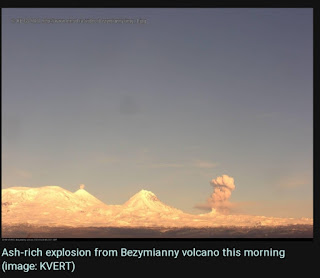
The activity at the volcano has been gradually increasing over the past few hours. A new explosion appeared from the summit, starting early this morning, at about 06:25 local time, the local institute KVERT reported. The eruption sent a grey ash column to nearly 13,000 ft (3,900 m) altitude that extended about 25 km towards the northeast. Furthermore, according to the KVERT observatory, there is a likelihood of a new viscous lava block that is being squeezed out from the actively growing lava dome and appears forming a "dome on top of a dome". Source: Kamchatka Volcanic Eruption Response Team volcano activity update 29 March 2023
Reported Selective Differentiation for Globe Seismic Activity
- Bağlantıyı al
- E-posta
- Diğer Uygulamalar
Documented Geomagnetic Storm Conditions
- Bağlantıyı al
- E-posta
- Diğer Uygulamalar
Shiveluch Developments
- Bağlantıyı al
- E-posta
- Diğer Uygulamalar

The extrusive activity of the volcano has increased. The local volcanologist Alexey Demyanchuk (volkstat.ru) carried out a field survey in the vicinity of the volcano a few days ago to report that the lava dome is growing again at intense values. The active lava dome continues to produce frequent incandescent rock falls to the south-southeast, from at least two active areas of the huge dome. From time to time, ash plumes separate from block-and-ash flows (so-called phoenix clouds) as it descends the slope. Emissions of gas and steam plumes with minor amounts of ash reached heights between 12,000 ft (3,700 m) and 15,000 ft (4,600 m) over the past few days. As time passes and the dome continues to grow larger and larger, the risk of a sudden, potentially very large collapse event resulting in massive pyroclastic flows and explosions increases. Source: volkstat.ru volcano activity update 29 March 2023
Reported Selective Differentiation for Globe Seismic Activity
- Bağlantıyı al
- E-posta
- Diğer Uygulamalar
Krakatau Developments
- Bağlantıyı al
- E-posta
- Diğer Uygulamalar

The explosive eruption at the volcano continues. A couple of intense vulcanian-sized eruptions took place from the cinder cone in the early morning today. Surveillance cameras of the PVMBG volcano institute observed at 04:12 local time a strong glow illuminating a broad part of the edifice. This might be a result of a short-term, but strong eruptive episode (likely to be classified as paroxysm) generating hot, juvenile and plastic ejecta landing onto various flanks of the volcano, but most often on the south slopes. Later on, at about 07:43 local time, an intense explosion generated a perpendicularly rising grey-to-black ash-abundant column to estimated 2,2 km height drifting northeast. The seismic network reported seismic signals with maximum amplitudes of 60 and 36,5 mm and a duration of 145 and 54 seconds. Source: Pusat Vulkanologi dan Mitigasi Bencana Geologi volcano activity update 28 March 2023 Update Mar29: The eruptive activity at the volcano is currently dominated by strong
Reported Selective Differentiation for Globe Seismic Activity
- Bağlantıyı al
- E-posta
- Diğer Uygulamalar
Lewotolo Developments
- Bağlantıyı al
- E-posta
- Diğer Uygulamalar

The activity at the volcano has been intensifying over the past two days. At first, an impressive red-to-orange lava fountain (so-called paroxysm) shot into the night sky up to perhaps several hundred meters above the summit crater in the early night yesterday. A moderate grey ash plume reached up to 6,900 ft (2,100 m) altitude and drifted toward the southeast direction. The intense manner continued even this morning at 08:45 local time as a relatively vigorous strombolian-to-vulcanian-sized explosion occurred from the main crater. The eruption created a grey-to-black dense ash column which rose about 750 meters above the summit and drifted northwest. In both cases, the local volcano observatory reported seismic signals with maximum amplitudes of 18.1 and 13.1 mm and durations of 56 and 32 seconds. The warning bulletin states that ballistic impacts of volcanic bombs and pyroclastic flows and lahars could affect an area of about 2 km distance from the main crater. Source: Pusat Vulkanol
Cotopaxi Developments
- Bağlantıyı al
- E-posta
- Diğer Uygulamalar

The Instituto Geofisico (IG) issued a special report on 21/03/23 outlining changes in the current eruptive period at Cotopaxi, which began on October 21, 2022. There is evidence of declining volcanic activity, with a decrease in monitoring parameters within the volcanic system and at the surface. Ash Emissions During the current eruptive period, the most common volcanic product has been ash emissions, which were most intense between December 2022 – February 2023, averaging ten events per week. In comparison, the week of March 13 – March 20 recorded only two ash emissions. The current rate is less than one event every two days. Seismicity The fragmentation of magma involves in ash emissions causes seismic tremors which are recorded. The current downward trend in seismicity at Cotopaxi is indicative of a decrease in internal movement and magma fragmentation at depth. Ash Fall The Washington Volcanic Ash Warning Centre (W-VAAC) reported 135 ash clouds since October 21, 2022, with a range
Popocatepetl Developments
- Bağlantıyı al
- E-posta
- Diğer Uygulamalar
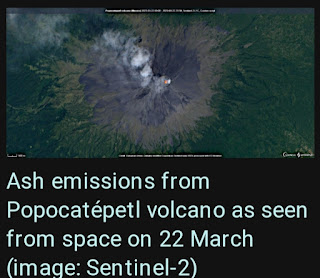
The eruptive activity at the volcano continues at moderately high levels. A relatively forceful explosion appeared from the main crater in the late evening yesterday, showering the upper part of the edifice with hot, glowing lava bombs. An eruption plume released ash emissions to estimated 7 km elevation and drifted east. According to the local monitoring institute CENAPRED, 235 emissions of water vapor, gases and ash were emitted over the past 24 hours. The internal activity represented 62 minutes of low-amplitude volcanic tremor including two volcano-tectonic earthquakes with a magnitude of M 1.4. The crater area of the volcano remains closed for climbing as the risk of being caught in sudden explosions is very high. The alert status remains unchanged at Yellow Phase 2. Source: Centro Nacional de Prevención de Desastres volcano activity update 26 March 2023 Update Mar28: Vulcanian activity continues from the summit crater. A spectacular explosion took place from the volcano in the
Merapi Developments
- Bağlantıyı al
- E-posta
- Diğer Uygulamalar

The phase of the intense activity has been continuing over the past two weeks. Near-frequent glowing lava blocks continue to regularly detach from the southwestern lava dome and tumble down along the main sliding southwestern slope, descending to the base of the edifice and reaching approx. 2 km length. By today, the main sliding pathway has branched off into another sliding arm in the south direction as glowing rock falls roll down over it. From time to time, phoenix clouds are being formed - lifted ash plumes rising above pyroclastic torrent as descending the flank. Update Mar29: Andi, our expedition guide and leader for VolcanoDiscovery Indonesia, is still on-site and provides first-hand information about the intense activity at Merapi. It seems that the situation has been gradually worsening over the past 24 hours as a number of glowing rock falls emanating from the southwestern lava dome has picked up. This presumably reflects continuing, pressurized, i.e. gas-rich magma under t
Reported Selective Differentiation for Globe Seismic Activity
- Bağlantıyı al
- E-posta
- Diğer Uygulamalar
Reported Selective Differentiation for Globe Seismic Activity
- Bağlantıyı al
- E-posta
- Diğer Uygulamalar
Villarica Developments
- Bağlantıyı al
- E-posta
- Diğer Uygulamalar
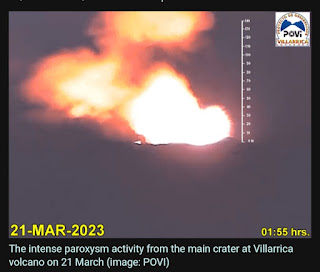
The volcano's activity is characterized by near-frequent strong eruptive episodes (so-called paroxysm) over the past few days. Bursting lava fountaining could be seen from the two-vent summit crater, surpassing perhaps a few 100 meters height. The Volcanic Alert Level remains at Yellow with 500 meters exclusion zone around the main crater in place. Intense strombolian activity returned to the main crater a few days ago after roughly one-month relative calm period. Source: Proyecto Observación Villarrica volcano activity update 24 March 2023 Update Mar29: The activity remains essentially unchanged at elevated levels. Another lava-fountaining episode (classified as paroxysm) occurred from the two-vent summit crater on the night of 26 March. The height exceeded by lava jets surpassed 100 meters, approx. 120 meters in maximum. According to the Proyecto Observación Villarrica (POVI), the active summit vents diameter finds measured to be about 13 meters. The Volcanic Alert Level remain
Reported Selective Differentiation for Globe Seismic Activity
- Bağlantıyı al
- E-posta
- Diğer Uygulamalar
Documented Geomagnetic Storm Conditions
- Bağlantıyı al
- E-posta
- Diğer Uygulamalar
Reported Selective Differentiation for Globe Seismic Activity
- Bağlantıyı al
- E-posta
- Diğer Uygulamalar
Reported Selective Differentiation for Globe Seismic Activity
- Bağlantıyı al
- E-posta
- Diğer Uygulamalar













